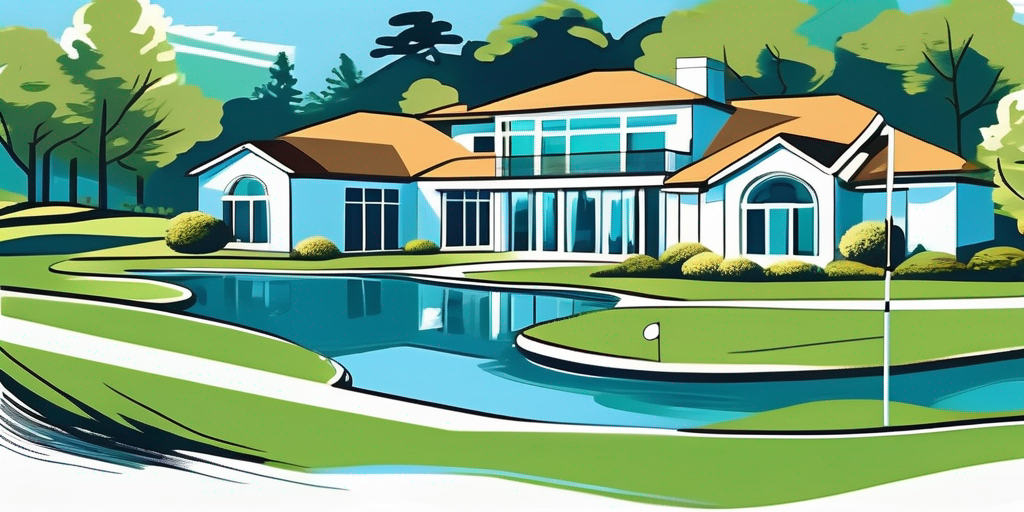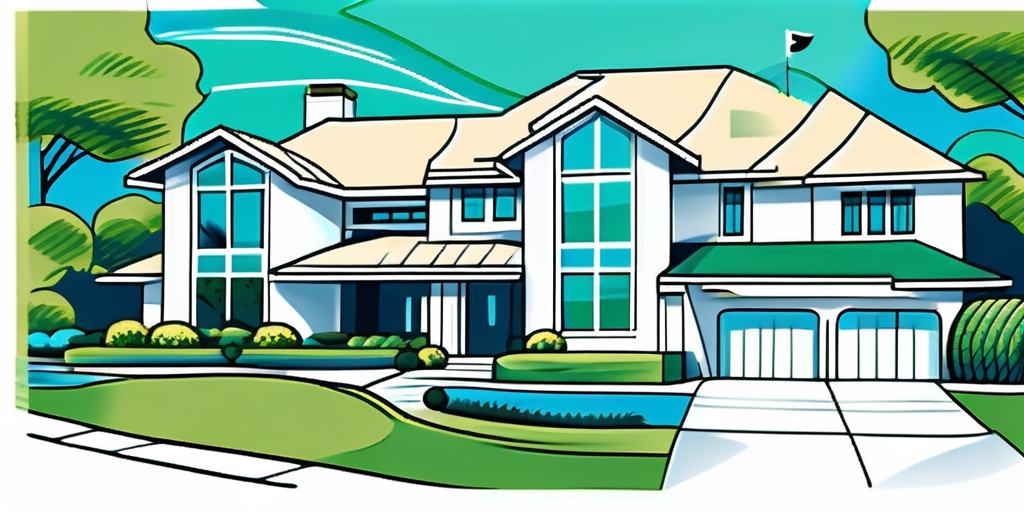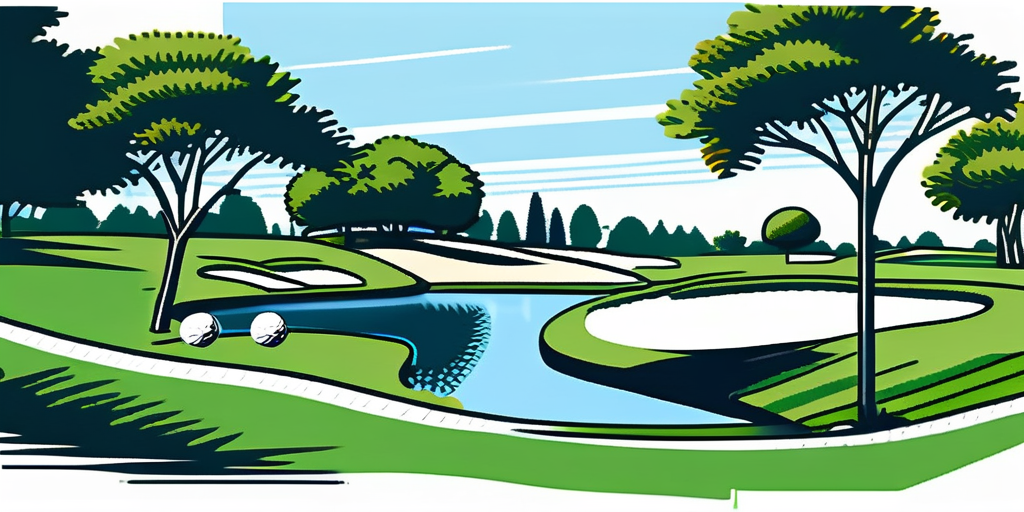
If you’ve ever dreamed of waking up to the sound of birds chirping and a scenic view of well-manicured greens, then golf course properties could be the perfect fit for you. Living near a golf course offers not just a luxurious address but a lifestyle that combines relaxation, recreation, and elegance. In this article, we’ll explore what makes these properties so desirable, the key features to look for, and how to navigate the buying process.
Golf course properties are homes that sit on or near a golf course, offering access to the lush grounds and the many amenities associated with golf living. These types of properties are often seen as prime real estate due to their unique charm and variety of features.
When it comes to luxury, each person has their own interpretation. In the context of golf course properties, luxury often involves high-end finishes, spacious layouts, and unique architectural styles. It may also encompass the lifestyle that comes with being part of a golf community, including access to exclusive events, social clubs, and luxurious amenities.
Luxury living is not just about the size of the home, but also about the quality of life. Residents often enjoy a peaceful atmosphere with private access to the fairways and greens, making it an oasis for golf enthusiasts and nature lovers alike. Many properties also feature expansive outdoor spaces, complete with patios, pools, and gardens, allowing homeowners to fully embrace the beauty of their surroundings. The integration of nature into daily life is a hallmark of golf course living, where the sights and sounds of the course become a part of the everyday experience.
One of the main attractions of golf course properties is the lifestyle they offer. Imagine stepping out of your backdoor to take a few swings or practice your putting skills while watching the sunset over the course. It’s a golfer's paradise! Moreover, these properties often have a sense of community, where neighbors share common interests in sports and outdoor activities. Many golf course communities host regular tournaments, social gatherings, and themed events, fostering a vibrant social scene that enhances the living experience.
Additionally, the potential for investment can't be overlooked. Golf course properties typically maintain their value due to desirability, providing homeowners with a solid financial asset. The allure of golf course living often attracts buyers from various backgrounds, including retirees seeking a serene lifestyle and families looking for recreational opportunities. This diverse demographic not only enriches the community but also contributes to the sustained demand for these properties, ensuring that they remain a sought-after option in the real estate market.
So, what exactly should you be looking for when considering golf course properties? Here are some key features that can elevate your living experience.

The architecture of golf course homes can range from modern and sleek to classic and traditional. Many properties boast expansive windows that provide stunning views of the greens, while others feature outdoor living spaces such as patios and balconies that make entertaining a breeze.
Whatever style you prefer, make sure the design integrates well with the natural landscape, allowing for seamless indoor-outdoor living. Additionally, consider the materials used in construction; high-quality finishes not only enhance aesthetic appeal but also ensure durability against the elements. Many homes incorporate eco-friendly materials and energy-efficient designs, which can lead to lower utility costs and a reduced carbon footprint, appealing to environmentally conscious buyers.
Amenities play a crucial role in golf course communities. Many feature clubhouses, swimming pools, fitness centers, and even spa services. These facilities enhance the quality of life for homeowners, providing spaces for relaxation and socialization.
Plus, the proximity to the golf course itself means residents often enjoy exclusive access to the course, or special rates, over the general public. Check to see if the property includes membership or if there are any additional fees involved. Beyond the golf course, many communities also offer walking trails, tennis courts, and organized social events that foster a sense of community among residents. This blend of recreational opportunities and social engagement can greatly enrich your lifestyle, making it easy to meet neighbors and build lasting friendships.
The beauty of golf course properties is often in their location. Positioned in serene areas with stunning landscapes, these homes offer more than just access to golf; they provide a scenic backdrop that contributes to a peaceful lifestyle.

Location is vital when purchasing a golf course property. Consider proximity to shopping areas, entertainment venues, and essential services. A shorter drive to amenities can significantly enhance your living experience.
Also, look for communities that have a strong sense of safety and security, as that can greatly influence your comfort level in the neighborhood. Many golf course communities also foster a sense of camaraderie among residents, often hosting social events and activities that allow for easy interaction and friendship-building. This community aspect can be particularly appealing for those looking to forge connections in a new area.
One of the biggest draws of living on a golf course is undoubtedly the picturesque views. Whether it's a stunning sunrise over the fairway or a calm sunset peeking through the trees, these sights add a unique value.
Make sure to view the property at different times of the day to appreciate its scenic potential fully. Scenic views don't just add beauty to your home; they can also have a positive impact on your mood and overall well-being. The natural surroundings often include lush greenery, vibrant flowers, and tranquil water features, creating a serene environment that can be enjoyed year-round. Additionally, the changing seasons bring new beauty to the landscape, from the vibrant colors of autumn leaves to the fresh blooms of spring, ensuring that the scenery remains captivating throughout the year.
Once you've decided that a golf course property is right for you, it’s time to dive into the buying process. This step can be exciting but also a bit overwhelming. Here’s what you need to know.
The home-buying process generally consists of the following steps:
Financing a golf course property can be more intricate than with traditional homes. Many buyers opt for jumbo loans or specialty mortgages that cater to luxury properties. It's essential to work with a mortgage broker who understands the nuances of this market.
Having your finances in order and being pre-approved can also strengthen your bargaining position, allowing you to make a more attractive offer for your luxury dream home.
Additionally, consider the potential for property appreciation in golf course communities. These areas often maintain high demand due to their desirable locations and amenities, which can lead to increased property values over time. Researching local market trends and historical data can provide valuable insights into the long-term investment potential of your chosen property.
Another important factor to consider is the homeowners' association (HOA) fees that may accompany properties in golf course communities. These fees can cover maintenance of common areas, security, and access to amenities such as clubhouses and pools. Understanding what these fees include and how they fit into your overall budget is crucial for making an informed decision. Be sure to ask about any upcoming assessments or changes in fees that could affect your financial planning in the future.
Owning a golf course property not only involves the excitement of living in such a magnificent space but also having to take on the responsibility of maintenance and upkeep.

Regular maintenance is critical to preserve the value of your investment. This includes landscaping, exterior maintenance, and ensuring that any shared community facilities are kept well. Consider hiring local professionals for tasks like lawn care and exterior cleaning. Regularly scheduled maintenance not only enhances the visual appeal of your property but also prevents larger, more costly repairs down the line. For instance, investing in seasonal landscaping can ensure that your garden remains vibrant and healthy throughout the year, while routine inspections of roofing and siding can help catch issues before they escalate.
Being part of a golf community may also require you to keep the property in line with community standards, which can include aesthetics and upkeep regulations. These standards often promote a cohesive look throughout the neighborhood, which can enhance property values and create a welcoming environment for residents and visitors alike. Engaging with your neighbors and participating in community events can also foster a sense of belonging and shared responsibility for maintaining the beauty of the area.
Many golf course properties are governed by homeowners associations (HOAs). These HOAs often have strict rules regarding property upkeep, rental policies, and community behavior. It's crucial to read through these rules thoroughly before purchasing to make sure they align with your lifestyle. Some associations may have specific guidelines regarding the types of landscaping allowed, the color of exterior paint, or even the types of fencing permitted, all aimed at preserving the aesthetic integrity of the community.
Understanding the HOA's fees and what they cover, as well as the penalties for not adhering to the rules, is essential to being a satisfied homeowner in such a community. These fees can contribute to the maintenance of common areas, security services, and amenities like pools or clubhouses, which can greatly enhance your living experience. Additionally, being aware of the process for addressing disputes or concerns within the HOA can help you navigate any potential issues that may arise during your time as a resident.
Living in a golf course community can also offer unique opportunities for social engagement and recreational activities. Many communities host events such as golf tournaments, holiday celebrations, and fitness classes, allowing residents to connect with one another and build lasting friendships. This sense of community can be a significant advantage, providing not just a place to live, but a vibrant lifestyle filled with activities and camaraderie.